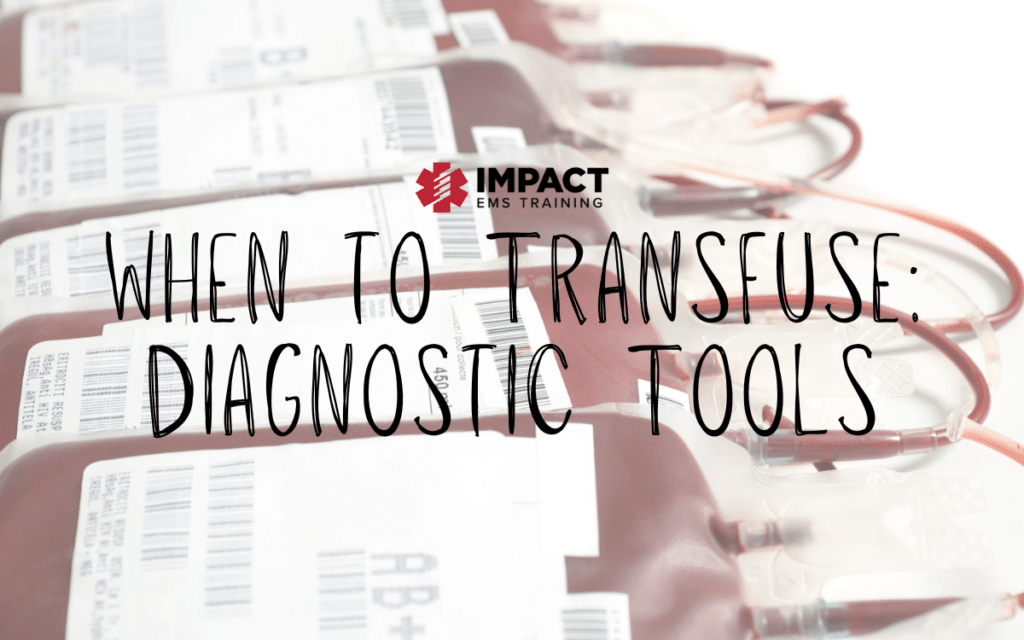When to Transfuse: Diagnostic Tools
The ability to transfuse critically ill patients before they even reach the hospital doors is becoming a reality for more programs every day. Over the past several years the tides have shifted to favor blood in for blood out, highlighting the importance this component plays in our normal physiology. There have been many attempts at a synthetic substitute but none have been able to produce the same benefits provided by blood. Despite this, blood component utilization has only just started trickling into the realm of prehospital medicine, likely due to prohibitive factors such as availability, storage, and proper utilization of this precious resource. It seems that most protocols fall flat when it comes to clearly defining indications for a transfusion. This is great if you prefer the latitude to rely on your experience, but not so great when you have had little exposure to these types of situations. Moreover, it always helps to have objective analysis when guiding our decision-making in high-stress situations. Thankfully, there is plenty of data evaluating assessment tools to help us understand which patients need to be transfused without the multitude of resources seen in the hospital.
Shock Index
The shock index (SI) is perhaps the easiest and most readily available score for prehospital clinicians. Calculated by dividing heart rate (HR) by the systolic blood pressure (SBP), SI is undoubtedly the quickest of the scoring tools at our disposal. Due to the simplicity, it is also the most nonspecific in this regard. There is a reason the shock index should be a consideration whenever we are assessing the need for transfusion: Mitra et al. (2014) found that when calculated after a 1 L bolus of IV fluid, a shock index ≥ 1.0 was able to identify patients with high specificity that would receive a transfusion within 1 hour of arrival. El-Menyar et al. (2019) evaluated 4500 trauma patients with a majority suffering blunt injury and found that a lower cutoff SI >0.8 correlated strongly with a need for blood transfusion.

Correlation with transfusion rises sharply with SI >0.8 (El-Menyar et al., 2019).
Early Blood Transfusion Needs Score
The primary issue with more complex scoring tools is the inclusion of diagnostics such as POCUS or blood analyzers that may not be available to prehospital clinicians. Wang et al. (2016) recognized this and developed the “Early Blood Transfusion Needs Score” to assess which patients may need blood based on a combination of objective criteria in a tool that does not require any specific equipment. They found that a score >5 on a scale of -4 to 17 as calculated based on the table below was predictive of the need for transfusion with specificity and sensitivity around 80%.

The score from each category is added for a total of -4-17 (Wang et al., 2016).
Assessment of Blood Consumption (ABC)
This scoring tool utilizes point-of-care ultrasound (POCUS) and adds the classification of penetrating trauma in addition to the data we use to calculate SI. Unlike many other scoring tools that utilize POCUS in their calculation, this system retains much of the simplicity of the SI and is even easier to calculate despite the addition of more variables. The non-weighted system assigns a value of 1 to each of the following: positive focused assessment sonography for trauma (FAST), arrival SBP ≤90, arrival HR ≥120, and penetrating trauma. Scores ≥2 were predictive of a need for massive transfusion when evaluated in two separate studies (Cotton et al., 2010; Nunez et al., 2009).
Emergency Transfusion Score
The next tool adds complexity by considering several different variables that range from mechanism to vital signs. Much like the ABC score, this tool uses an additive system that ranges from 2-9.5 with a cutoff of ﹤3 to determine patients that do not need blood with excellent sensitivity. As the score approaches 9.5 the correlation with a need for transfusion rises exponentially, reaching 95% (Alimohammadi et al., 2017; Kuhne et al., 2008). Due to the complexity, this scoring tool may not be ideal for use by prehospital clinicians to determine a need for emergent transfusion. On the other hand, most of these variables are readily obtained before arrival at the hospital and it is worth noting the weight of each item as it pertains to the scoring system to better understand the risk factors.

The score from each applicable item is added for a total score of 2-9.5 (Alimohammadi et al., 2017).
Conclusion
The different scoring tools here represent a range of options from quick and simple to the more complex, including the use of technology like POCUS in the more complicated systems. The ability to assess patients that may need a transfusion is a critical skill that must be performed in concert with resuscitation. Utilizing fluids judiciously and providing patients with early blood transfusions has the potential to significantly improve outcomes in patients that may otherwise receive delayed care. Where available, POCUS enhances our decision-making capabilities with the benefit of additional scoring systems but these time-sensitive interventions should not be delayed based on the lack of such tools. The simpler scoring systems excel at identifying patients in need of blood transfusion because of their focus on the details we care about addressing most: a state of hypoperfusion. These objective assessment tools coupled with careful patient assessment can assist prehospital clinicians with determining the need for early blood transfusion with greater accuracy as more systems begin carrying blood products.
References
- Alimohammadi, H., Kianian, Y., Zerepoosh, F. B., Derakhshanfar, H., Alavi-Moghadam, M., Hatamabadi, H. R., & Hosseini-Zijoud, S. M. (2017). Accuracy of emergency transfusion score in prediction need for blood transfusion among multiple trauma patients: A cross-sectional study from Iran. International journal of critical illness and injury science, 7(4), 248–251. https://doi.org/10.4103/IJCIIS.IJCIIS_118_1
- Cotton, B. A., Dossett, L. A., Haut, E. R., Shafi, S., Nunez, T. C., Au, B. K., Zaydfudim, V., Johnston, M., Arbogast, P., & Young, P. P. (2010). Multicenter validation of a simplified score to predict massive transfusion in trauma. The Journal of trauma, 69 Suppl 1, S33–S39. https://doi.org/10.1097/TA.0b013e3181e42411
- El-Menyar, A., Jabbour, G., Asim, M., Abdelrahman, H., Mahmood, I., & Al-Thani, H. (2019). Shock index in patients with traumatic solid organ injury as a predictor of massive blood transfusion protocol activation. Injury epidemiology, 6, 41. https://doi.org/10.1186/s40621-019-0218-7
- Kuhne, C. A., Zettl, R. P., Fischbacher, M., Lefering, R., & Ruchholtz, S. (2008). Emergency Transfusion Score (ETS): a useful instrument for prediction of blood transfusion requirement in severely injured patients. World journal of surgery, 32(6), 1183–1188. https://doi.org/10.1007/s00268-007-9425-4
- Mitra, B., Fitzgerald, M., & Chan, J. (2014). The utility of a shock index ≥ 1 as an indication for pre-hospital oxygen carrier administration in major trauma. Injury, 45(1), 61–65. https://doi.org/10.1016/j.injury.2013.01.010
- Nunez, T. C., Voskresensky, I. V., Dossett, L. A., Shinall, R., Dutton, W. D., & Cotton, B. A. (2009). Early prediction of massive transfusion in trauma: simple as ABC (assessment of blood consumption)?. The Journal of trauma, 66(2), 346–352. https://doi.org/10.1097/TA.0b013e3181961c3
- Wang, H., Umejiego, J., Robinson, R. D., Schrader, C. D., Leuck, J., Barra, M., Buca, S., Shedd, A., Bui, A., & Zenarosa, N. R. (2016). A Derivation and Validation Study of an Early Blood Transfusion Needs Score for Severe Trauma Patients. Journal of clinical medicine research, 8(8), 591–597. https://doi.org/10.14740/jocmr2598w
Impact EMS offers accredited certification and refresher courses in one trusted location. Fully prepare for certification exams and maintain licensure with skill building credits.





